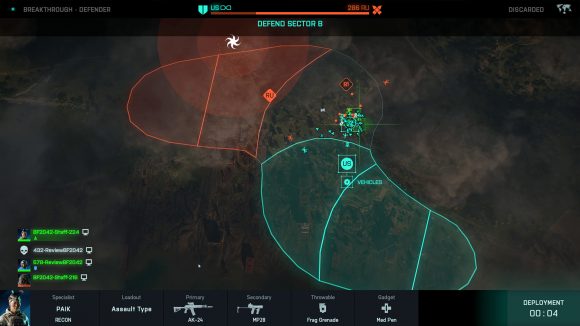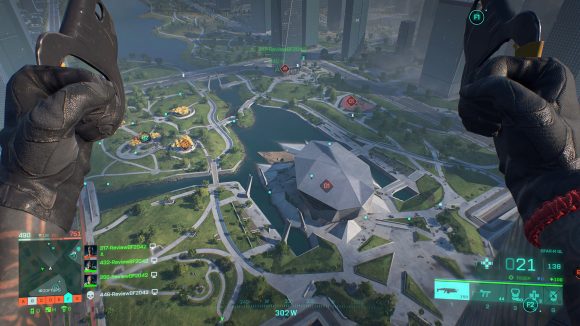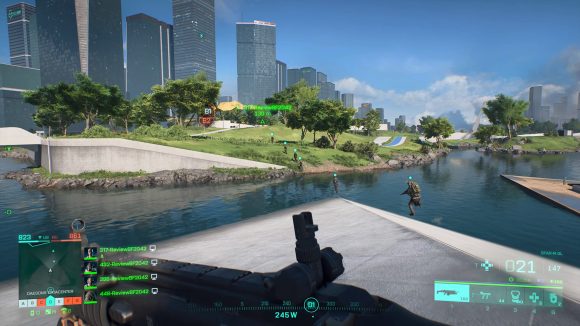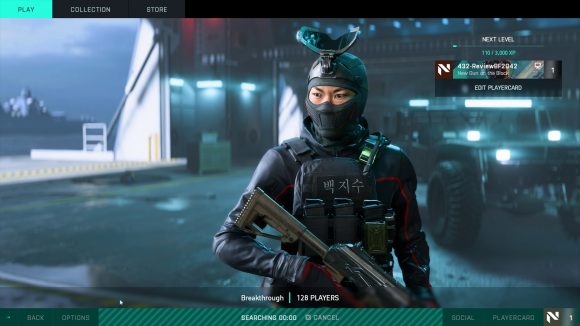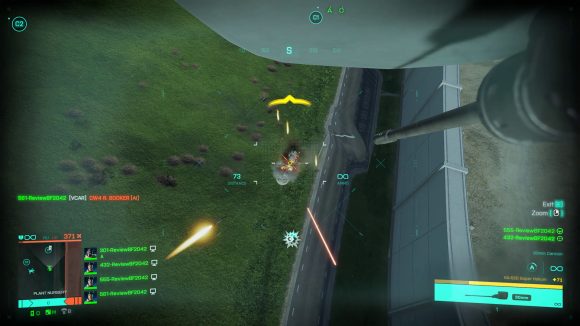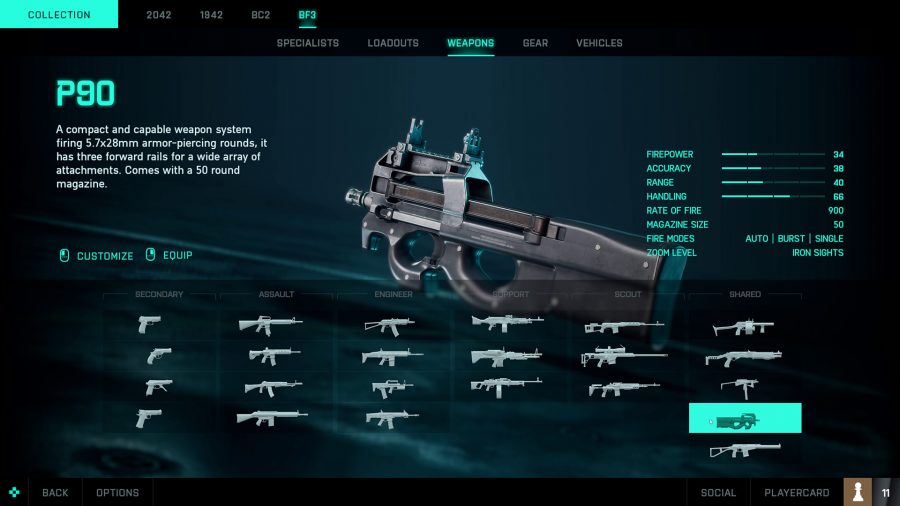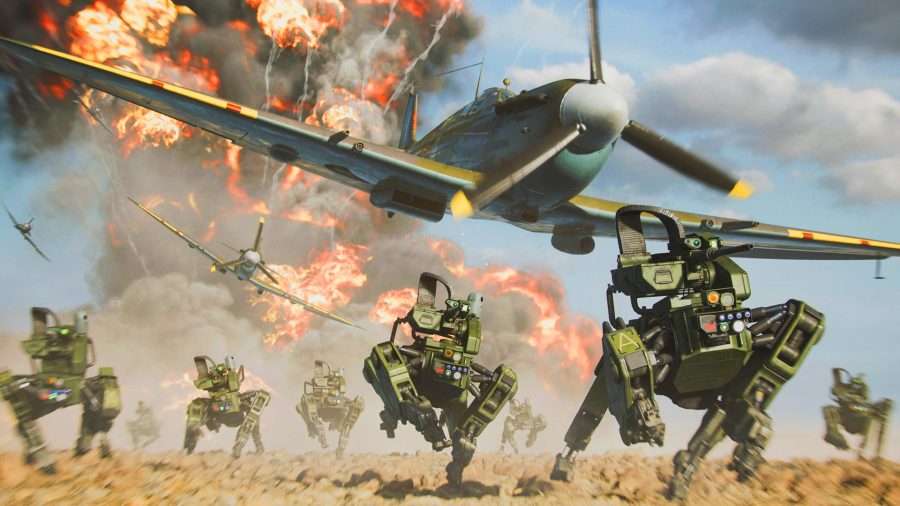Our Verdict
This near-future sequel has all the components it needs to become a classic entry in the multiplayer series, but it feels like 2042 is many updates away from reaching its full potential.
The Battlefield series has always strived to deliver multiplayer moments that you can’t get anywhere else. Jumping out of a jet, sniping another pilot, and hijacking their jet in Battlefield 3; levelling buildings in Battlefield: Bad Company 2; parachuting away from a collapsing skyscraper in Battlefield 4 – when it comes to scale and bombast, DICE regularly knocks it out of the park. Other times, the studio has taken a swing and a miss by trying something completely different, like Battlefield 2142, an experiment in future warfare that launched with countless issues and sparked some wariness in my 13-year-old self about buying multiplayer games at launch.
Battlefield 2042’s reveal trailer shows that DICE is doubling down on what it’s known for: fun over realism, chaos over order, and plenty, plenty of ‘Battlefield moments’. Set in the near future, the FPS game depicts a world wracked by the effects of climate change and the collapse of the European Union. It’s a pretty bleak prophecy, with many cities being ravaged by tornadoes, sandstorms, massive battles, and sometimes all three. But at least the soldiers are having a good time: they can modify their weapons while running around, or hitch a ride on tornadoes and then use their newfangled wingsuits to glide to safety. Maybe the future won’t suck.
Climate crisis aside, warfare doesn’t appear to have changed all that much. Battlefield’s classic Conquest and Breakthrough modes return, scaled up with even larger maps and clustered capture zones rather than flags dotted around the map, all to accommodate the new 128-player count. Breakthrough, the latest incarnation of the long-running Rush mode, divides players into attacking and defending armies that fight over a linear series of objectives to establish dominance across the whole map.
The increased player count is much more noticeable when a tornado arrives and sucks everyone up into one magnificent cyclone. Seeing dozens of friendly teammate icons twirling around the sky is the only time when Battlefield 2042 really feels massive, and while I can’t imagine the sheer, silly fun of zooming around in a tornado wearing off any time soon, it doesn’t really add anything to a match. You might struggle to spot enemies in the distance when a storm starts up on Orbital, or when a sandstorm rolls in on Hourglass, completely obscuring a tank battle that you were hoping to get in on. Don’t worry, a tornado isn’t going to randomly launch you into the air while you’re fighting, unless you’re very situationally unaware. There’s a chance I’ve been extremely lucky with the weather effects, but they haven’t changed the tide of battle very much on their own just yet.
For series veterans, the game-changing addition is Battlefield Portal, a sandbox filled with the best maps, weapons, and vehicles from previous games in which players can create custom modes using a detailed logic editor to mix eras together. For example, there’s a Battlefield 1942 vs 2042 mode which splits teams by era as they fight in the Battle of the Bulge. The 2042 specialists have access to all of their modern tech, while the 1942 soldiers are lumped with the classic class system and gear from the past.
 Battlefield 2042 Battlefield 2042 $59.99 Buy now Network N earns affiliate commission from qualifying sales.
Battlefield 2042 Battlefield 2042 $59.99 Buy now Network N earns affiliate commission from qualifying sales.
DICE has set up official playlists in Portal that allow players to experience 1942, Bad Company 2, and Battlefield 3 in the new engine. Rediscovering classic game modes in Portal feels fantastic for the first few hours, but there isn’t enough content from each game to keep the experience feeling fresh, and this is no stand-in for Bad Company 3. Fighting on Arica Harbor brought back a flood of memories that I completely forgot about, but playing on the same two Bad Company maps gets stale quickly. Fortunately, new content is coming to Portal alongside the seasonal content for the main game, but it could be too late for some.
Despite the inclusion of cross-platform play, it looks like custom Portal modes aren’t very popular. The server browser rarely contains more than a handful of servers at max capacity, though this may be down to the number of progression farms on offer. There’s also a limit on the number of custom servers that can be live at any given time, and a lot of the spaces are currently being used by the same type of server. Shortly after the early access launch, experience gain was disabled in Portal to address this, but these servers still keep cropping up.
Creating custom game modes in Portal feels intuitive using the basic rules editor, but there’s one big restriction a lot of creators are struggling with: the lack of offline or private play. Right now, there’s no way for creators to test their servers without hosting their server online. If the server slots are fully occupied, your only option is to wait until space becomes available. This seems like a huge oversight, but with any luck this can be addressed in a future update. I’ve only managed to sample a handful of community setups so far, but the potential is plain to see and I can’t wait to see what the community does with Portal.
Hazard Zone is Battlefield’s take on battle royale, but with a twist inspired by Escape from Tarkov. In this mode, squads of four must locate and retrieve data drives scattered throughout the map. Not only do teams have to fight against each other, they’ll also have to contend with AI soldiers to get at some of the drives, and you may have to deal with the environment kicking up a storm, too. There are only two opportunities to extract the drives before the area turns into the titular hazard zone, and only one team can be extracted during each exfil period. If you miss your chance to leave, you end the game with nothing.
Players are rewarded with Dark Market Credits if they successfully kill enemies and retrieve data drives. This currency is exclusive to Hazard Zone; it allows you to purchase weapons and items at the beginning of a match to increase your chances of winning. If you go on an extraction streak, the items in the store are discounted, so you can set yourself up with some especially pricey gear. The longer your streak, the bigger the discount. Featuring just 32 players, Hazard Zone is a more intimate and gentle take on Battlefield’s multiplayer chaos that attempts to add a risk/reward element to keep players coming back for more.
Playing this mode with teammates who won’t communicate is not a lot of fun. You can scrape by in most battle royale games without ever talking to your team, which is great if you’re just after a quick match, but Hazard Zone requires you to strategise and establish roles within your squad if you want to survive. You can’t respawn in this mode either, so if you get knocked down and eliminated, you have to wait for your teammates to find a redeploy uplink to get back into the fight.
Before starting a match squads are strongly encouraged to equip an intel scanner to reveal data drive locations, but while you can see your team’s individual loadouts in the deploy menu, there’s no guarantee that a teammate will actually use it. As robust as Battlefield 2042’s ping and callout systems are, they only matter when your team is paying attention to the signals you send out. You can’t force anyone to play together, and while this might not make a big difference in the other modes, it makes Hazard Zone an arduous slog without friends or communicative strangers by your side.
I’m also struggling to understand the appeal of Hazard Zone for new players, even if they’re playing with pals. Players that regularly win in this mode should have plenty of Dark Market Credits at their disposal, so why would a group of new players want to jump into a mode where the likely winners are people that have accumulated lots of in-game cash already? And it’s not like you’re only ever a couple of kills away from a decent starting loadout either – you’ll need several kills and multiple data drives to bankroll your next run. You could save your cash to compete against the experienced players, but you only have limited chances to succeed before you’re back at square one.
Aside from extreme weather and new modes, the other major change in 2042 is the arrival of specialists, which replace Battlefield’s tried and tested class system, giving players the flexibility to create loadouts that wouldn’t have been possible in the older games. If you want to equip a shotgun with an ammo supply crate as a Medic, that’s finally possible in Battlefield 2042.
This level of customisation ensures players aren’t wasting their unique gadgets by being forced into a class they didn’t want to play just for their weapons, and this is a godsend for solo players and casuals. This doesn’t mean teamwork is dead, but now solo players can really do their own thing without it spoiling the squad composition for everyone else.
Specialists also bring gadgets and traits to the table, and it seems that some are significantly better than others. Mackay’s grappling hook enables him to access areas that no other specialist can reach. While the grappling hook is very fun to use, it’ll be beaten every time by a coordinated squad with complementary gadgets and traps. It’s easy to look at the gadgets individually and assume they aren’t powerful, but there are heaps of synergies to explore when you start mixing them both with your squadmates, and with the supporting gadgets in your loadout.
There are some genuinely innovative strategies that are only made possible by the specialist system. For example, Casper, one of the recon specialists, can use his OV-P Recon Drone to spot incoming enemies. This leaves him vulnerable, but engineer specialist Irish can deploy a shield to keep Casper safe. Meanwhile, Boris can complete the fortification by deploying his SG-36 Sentry Gun, which in turn feeds off the intel from Casper’s drone.
No matter what mode you’re playing, the brand new plus system is always active, allowing you to switch your weapon attachments on the fly. Unlike the beta build, there are dozens of attachments to pick from on each weapon – far too many to actually pick from in the heat of battle – so if you want to use the plus system you’ll need to allocate a set of attachments in the loadout menu before starting a game. It’s definitely unrealistic, but it’s great for figuring out what your best setup is, and it’s refreshing being able to switch from long-range engagements to CQB fights without having to die first.
There have been a lot of complaints from the Battlefield community about the game launching with 22 weapons, but the right set of attachments can have drastic effects on the Battlefield 2042 guns if you choose them correctly. Grab an AK-24 and load it up with two sets of attachments that suit a wider variety of engagements, and you’ll quickly realise that you don’t need more firearms to choose from.

Battlefield 2042 is running on the latest version of the Frostbite engine, and it really does look incredible if you have a high-end computer with an HDR display. It’s not all good news, however, as I’ve had numerous flashbacks to that younger version of myself who tried in vain to get Battlefield 2142 to run smoothly.
Despite featuring every setting known to boost frame rates like Nvidia Reflex and DLSS, I was averaging less than 60fps at 4K with the high settings preset. Given the quality of the visuals, maybe this shouldn’t be too surprising, but it feels like a Ryzen 3900x and RTX 3080 should be capable of more.
2042 definitely runs smoother in Hazard Zone compared to Conquest or Breakthrough, and that’s most likely due to the lack of vehicles and a lower player count. I tried switching to a 1440p display which boosted my frame rate even further, but then my mouse stopped responding correctly. No matter what settings I altered, my mouse cursor was always delayed by a second, causing my first session to be borderline unplayable. This didn’t occur in subsequent sessions, which is odd because the game, and indeed my setup, hasn’t received an update. It’s great that it’s working now, but it doesn’t instill much confidence.
The series hasn’t exactly been blessed with smooth launches over the years, so fans may already be expecting issues like this. Likewise, while 2042 has some really awesome new tools in its locker, they’re additive rather than revolutionary. Huge, gorgeous maps, a ton of vehicles to sow chaos with, and now actual tornadoes to bump the thrills beyond 11.
This is still a giant playground packed with catalysts and gadgets that are ready and waiting to be worked into a player-made set piece. It feels as cool as ever when you manage to create one of these in the middle of a match, and it’s in these moments when Battlefield asserts itself in the multiplayer FPS space. When everything works, Battlefield 2042 is easily one of my favourite games in the series. But it’s rare to make it through a match without feeling like something has rattled loose from deep inside the game engine, and no amount of Portal-induced nostalgia can mask the feeling that this game feels rushed out the door.
 Battlefield 2042 Battlefield 2042 $59.99 Buy now Network N earns affiliate commission from qualifying sales.
Battlefield 2042 Battlefield 2042 $59.99 Buy now Network N earns affiliate commission from qualifying sales.

